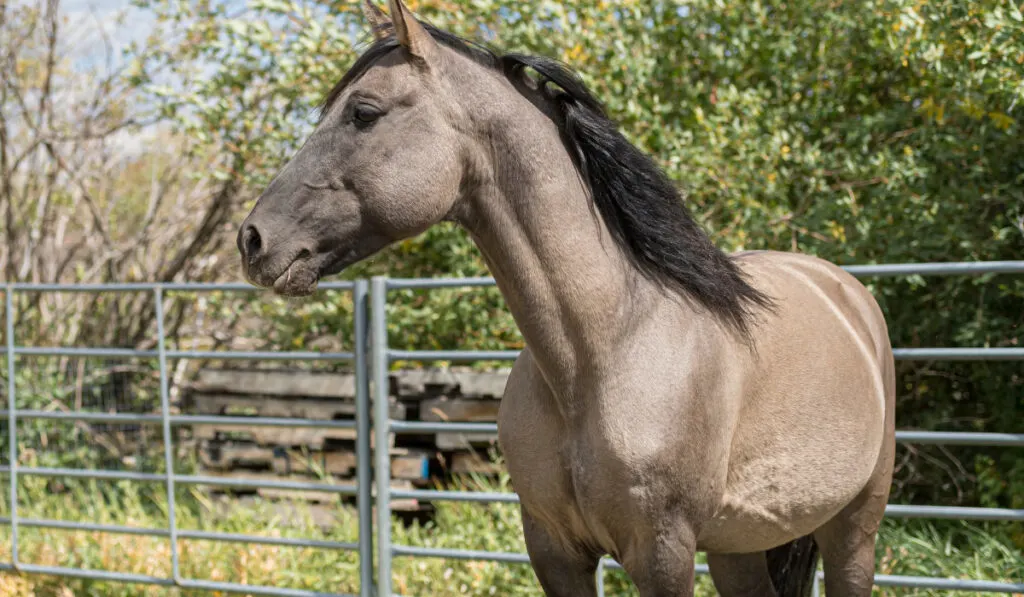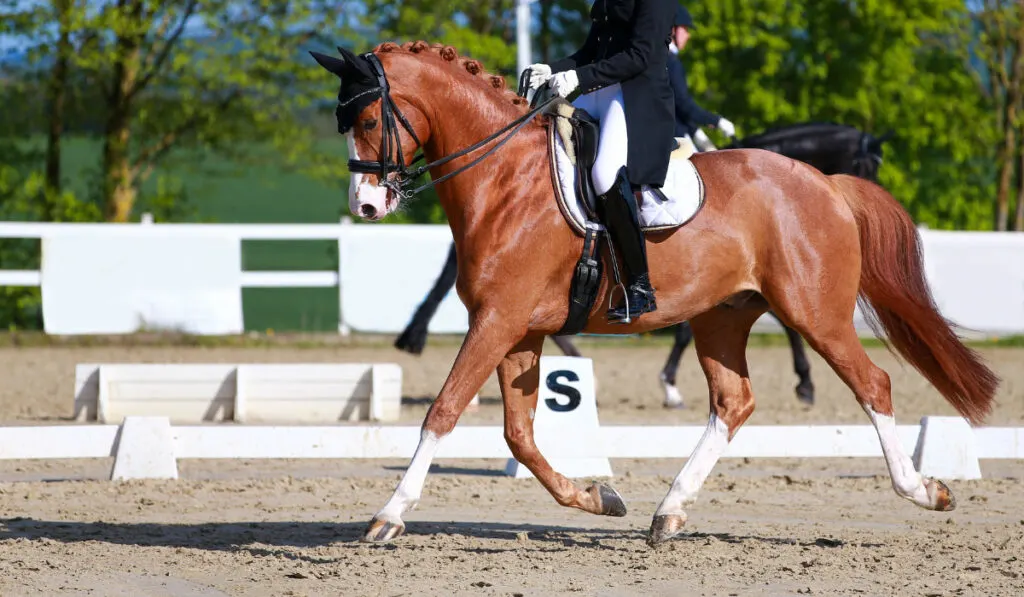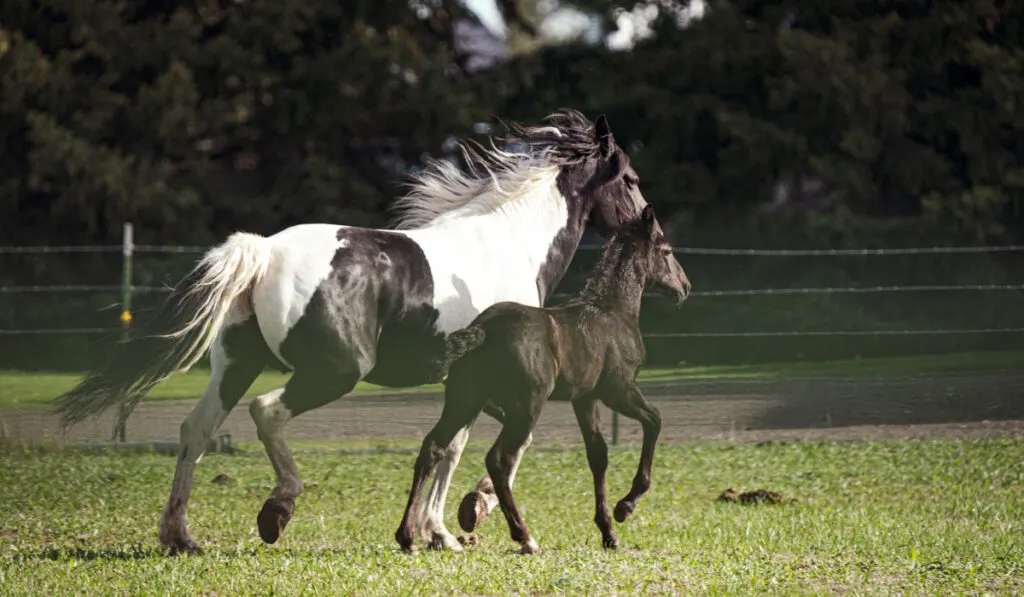Missouri Fox Trotters are riding and driving horses well-known for their smooth gaits, sure footedness, and natural ability around livestock.
This breed originally hails from – you guessed it – Missouri and can trace its origins back to a combination of the Morgan, American Saddlebred, Tennessee Walking Horse, and Arabian breeds.

Because it took a very specific horse to work livestock, plow fields, and help at logging camps in the rocky and unyielding terrain of the Missouri Ozarks, this combination was very selectively honed down.
In 1948, the breed itself was established to maintain the selective breeding that created the distinct Missouri Fox Trotter and set forth specifications for registration to keep the breed true to its roots.
The Fox Trotter quickly became a favorite amongst people from all walks of life as the breed offered a ground-covering gait, a comfortable ride, and a gentle disposition.
From doctors to farmers, the Missouri Fox Trotter captured the heart of the Ozarks no matter if they were being used as a stylish buggy horse or as the reliable mount a working man could depend on to get a day’s work done.
Table of Contents
The Missouri Fox Trotter Today
Today, this breed is commonly enjoyed by trail riders who put faith in the breed’s stamina and comfortable gaits.
The Missouri Fox Trotter is known as “every person’s pleasure horse.”
The US Forest Service also employs Missouri Fox Trotters as a worthy mount for their line of duty.
Did you know that Fox Trotters were used in the first horse-back trek down the North Rim of the Grand Canyon?
The Gaits
The Missouri Fox Trotter is a gaited horse, meaning it moves in gaits outside of the standard four-beat walk, two-beat trot, three-beat canter, and four-beat gallop.
The gaits of the Missouri Fox Trotter are part of its appeal and individuality.
The breed’s difference begins even at the walk, as they traditionally over-stride the front track with the hind hoof and smoothly swing their head in cadence with the hind feet.
The tell-tale “Fox Trot” is a broken, diagonal gait, however the unique rhythm is found as the front hoof lifts a split second before the opposite hind hoof.
This means that the horse is always in contact with the ground and creates an incredibly smooth gait.

because this gait is diagonal movement (opposite front and hind legs move together) versus other gaited breeds, it keeps the Missouri Fox Trotter sure-footed and trustworthy.
The canter of the Fox Trotter can be either an “athletic lope” or a “collected rocking chair canter” per the breed specifications at the Missouri Fox Trotting Horse Breed Association. Both are a classic, three-beat movement.
Breed Specifications
It is not just the gaits that make this breed unique. The build and specifications of the Missouri Fox Trotting Horse Breed Association registry compile a list of traits which are believed to be pertinent to the breed.
A direct quote from the rulebook of the Missouri Fox Trotting Horse Breed Association:
The Missouri Fox Trotting Horse generally stands between 14 and 16 hands in height, and averages between 900 to 1200 pounds. The horse should stand well on its feet, be erect, wide awake and alert.
The neck should be graceful, in proportion to length of body, and joined to the body in a manner pleasing to the eye. The fox-trotting horse should have a neat, clean, symmetrically shaped head of medium length; pointed ears that are well shaped; eyes that are large, wide set and bright; and a tapered muzzle with large nostrils”.
Missouri Fox Trotting Horse Breed Association
The hardiness and beauty of the Fox Trotter shines through from a history of selective breeding and these beautiful horses can be found in nearly every color and discipline imaginable.
There is now even a Missouri Fox Trotting Pony registry for those individuals that fall below 14.2 hands high.
Why Own a Missouri Fox Trotter?
While the Missouri Fox Trotter is commonly enjoyed by trail riders, there are several competitions specifically hosted to celebrate this breed. The largest is the Missouri Fox Trotting Horse Show and Celebration, hosted in Ava, Missouri.
Once upon a time, over 60 years ago, the first event was held and consisted of one show day. Now, the event covers an entire week and seeks to showcase the versatility of the breed.

The event boasts organized trail rides, the Fox Trot Playground, ranch sorting, and over 130 classes!
Spectators from all over the world come in to appreciate and admire the breed back where it all began.
As of 2012, there were over 100,000 Missouri Fox Trotters registered in the United States.
The breed association strives to preserve and promote the breed for its incredible functionality, beauty, and fun.
In 1992, Europe began their own registry and today there are around 600 Missouri Fox Trotters living in Europe and registered with the German-based association.
Prices on Missouri Fox Trotters tend to stay around the mid four figures, depending on the level of training and age.
Higher quality show horses can go for anywhere from $15,000 to $20,000 while trail and pleasure horses can be found closer to $5,000 to $7,000 based on our current research.
They seem to be an equally affordable option to other registered stock and pleasure horses.
Whether you are looking for a new trail riding companion, a smooth gait to enjoy, a striking show horse, or a horse you can just enjoy being around, the Missouri Fox Trotter has earned its title as “every person’s pleasure horse.”
Resources:
For more information about Missouri Fox Trotters, see the sources used in this post:
- https://en.wikipedia.org/wiki/Missouri_Fox_Trotter
- https://mfthba.com/
- https://mfthba.com/rulebook/20/

